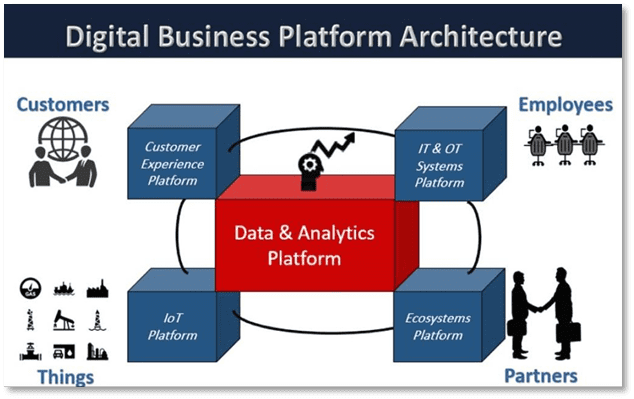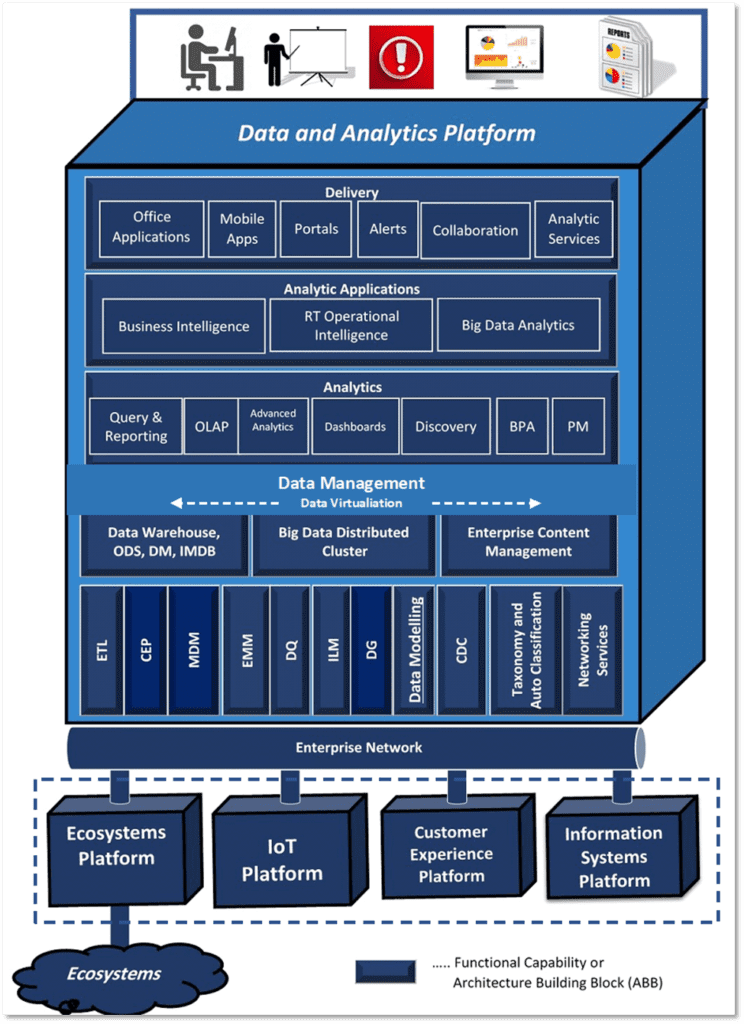
Data and Analytics Platform is a sub-platform of the Enterprise Digital Business Technology Platform. It contains information management and analytical capabilities.

Introduction
Building the digital business technology platform is a core aspect of enterprise endeavors to support its digital business transformation and therefore gain a sustainable competitive advantage. The digital business technology platform includes 5 building blocks: the information systems platform, the customer experience platform, the internet of things (IoT) platform, the ecosystem platform, and the data and analytics (D&A) platform. The D&A platform is located at the heart of the enterprise digital business technology platform.
In many cases, modernizing the traditional D&A platform is one of the essential steps an enterprise should take in order to build its digital business platform, therefore enabling its digital business transformation and gaining a sustainable competitive advantage. Figure 1 depicts an example of a roadmap for building the enterprise digital business platform.

So, this series of articles is intended to help enterprises determine what parts of the existing traditional D&A capabilities are missing or need to be improved and modernized. It provides conceptual-level reference architectures of traditional and modern D&A platforms. It also explains how these reference architectures can be used (along with the business strategy) to determine what parts of the traditional D&A platform are missing or need to be improved and modernized.
Part 1 of this series provides a conceptual-level reference architecture of a traditional D&A platform.
Part 2 provides a conceptual-level reference architecture of a modern D&A platform.
Parts 3 and 4 explain how these two reference architectures can be used to modernize an existing traditional D&A platform. They illustrate this by providing an example of a Transmission System Operator (TSO) that modernizes its existing traditional D&A platform in order to build a cyber-physical grid for Energy Transition. However, the approaches used in this example can be leveraged as a toolkit to implement similar work in other vertical industries such as transportation, defense, petroleum, water utilities, and so forth.
It is worth noting that in this series, traditional D&A capabilities that normally exist in many enterprises will be referred to as “traditional Data & Analytics platforms” and that for simplification purposes – although they may not be built on services-based principles and architecture.
Reference Architecture of Traditional Data and Analytics Platform
The reference architecture of traditional D&A platform comprises several functional capabilities (see Figure 2).

(The dashed-line rectangle surrounds the other sub platforms that should be connected to the D&A platform after it is modernized)
From an enterprise architecture perspective, each D&A capability shown in Figure 2 includes a grouping of functionality and can be considered as an Architecture Building Block (ABB). ABBs are mapped into real products or specific custom developments (Solution Building Blocks). Following are the most common ABBs of traditional D&A platform reference architecture, sorted in alphabetical order:
Advanced Analytics is a collection of related analytic techniques and tools, which usually includes predictive analytics, data mining, statistical analysis, and complex SQL
Alerts is used to deliver automatic notifications via reports, dashboards, email, or mobile device according to a set of prespecified conditions or rules
Analytic Servicesis used to provide the ability to embed analytics capabilities into other software applications
Big Data Analytics is applications used to apply advanced analytics into big data sets
Big Data Distributed Clusteris used to support big data analytic applications by obtaining results and reporting them to an interface (e.g. Hadoop MapReduce processing clusters)
BPA(Business Process Analytics) is used to analyze business processes. This class of analytics normally presents a part of a business process management solution
CDC(Change Data Capture) is used to track and determine the data that has changed so that action(s) can be taken using it
CEP (Complex Event Processing) is an event-driven computation capability used to track and process real-time events. It supports continuous-intelligence applications used to enhance situation awareness and support real-time decisions.
Collaboration is used to provide capabilities such as annotations, discussion threads, blogs, wikis, and Really Simple Syndication (RSS)
Dashboards typically display information into a user interface to focus user attention on important exceptions, trends, and conditions
Data Modelling is used to build different levels and types of data models (e.g. conceptual, logical and physical level data models; relational and dimensional data models)
Data Virtualization is used to provide virtual views that represent information in forms that applications and users need in real-time or near-real-time
Data Warehouse as defined by Bill Inmon is a subject-oriented, integrated, time-variant, and non-volatile collection of data in support of management’s decision-making process
Discovery is used to enable users to develop and refine views and analyze structured and unstructured data by visually navigating data or applying guided advanced analytics
DQ (Data Quality) is used to address various aspects of the data quality problems such as data profiling, cleansing and enrichment
ECM (Enterprise Content Management) is used to create, store, distribute, discover, archive, and manage unstructured content
EMM (Enterprise Metadata Management) is used to manage the descriptive data about information objects. It supports establishing policies and processes that ensure information can be integrated, accessed, shared, linked, analyzed, and maintained to best effect across the organization.
ETL (Extract, Transform and Load) is used to automate the process of finding data, integrating it, and placing it into a data warehouse
ILM (Information Lifecycle Management) is used to align the business value of information with the most appropriate and cost-effective IT infrastructure from the time information is created through its final destruction.
IMD (In-Memory Database) is a full-featured, standalone database running in-memory that supports data processing APIs (e.g. SQL)
MDM (Master Data Management) is used to ensure the uniformity, accuracy, stewardship, semantic consistency and accountability of the enterprise’s shared master data
Mobile Apps is used to extend portal and collaboration capabilities to mobile devices so that mobile users can access the same content
Networking Services is used to provide robust interconnectivity between the D&A platform (after modernizing it) and the other platforms of the enterprise digital business platform (i.e. the customer experience platform, the ecosystem platform, the information system platform, the IoT Platform) and their associated subsystems
ODS (Operational Data Store) is used to support operational decision support system applications
Office Applications is used to deliver analytic results through industry-standard office applications such as MS Word, Excel, and PDF files
OLAP (Online analytical processing) is used to enable users to analyze multidimensional data interactively from multiple perspectives
PM(Performance Management) is used to monitor and manage the business performance of an enterprise
Portals are websites with a wide range of content, services, and links, used to offer such services as Web searching, news, and communications capabilities including e-mail and chat rooms.Also, for an ideal managed hosting service, you can get along with the ultimate Laminas Hosting that speed up and assist you in managing and launching your websites in minutes
Query & Reporting is used to provide analytical and operational reports and ad-hoc queries
RT Operational Intelligence is real-time dynamic business analytics that delivers visibility and insight into data, streaming events, and business operations
Taxonomy & Auto Classification
(Taxonomy) is a large classification of data used to organize and understand textual, unstructured data (equivalent to a data model for structured data).
(Autoclassification) capability is used to classify textual, unstructured data according to specific taxonomies.
Conclusion
The traditional D&A platform reference architecture includes four main architectural building blocks, namely, the data management, the analytics, the analytics applications, and the delivery. In many cases, for an enterprise to build its digital business technology platform, it must modernize its traditional D&A architecture. Such a modern D&A platform should be built on services-based principles and architecture. It should also be able to provide the context for compliance and reporting; real-time event analysis and adjustments to processes; data and models that allow decisions to be made; and algorithms that automate decisions and prescribe courses of action that can be executed in all of the other digital business sub-platforms. The next article (Part 2) will provide a reference architecture of a modern D&A platform, and Parts 3 and 4 will explain how these two reference architectures can be used to modernize an existing traditional D&A platform.
